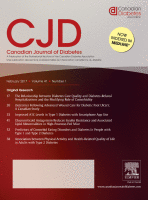The Visceral Adiposity Index in Comparison with Easily Measurable Anthropometric Markers Did Not Improve Prediction of Diabetes
Authors
Affiliations
Abstract
Objectives: We evaluated the ability of the visceral adiposity index (VAI) compared to hypertriglyceridemic-waist (HTGW) phenotype, body mass index (BMI), waist circumference (WC), waist-to-height ratio (WHtR) and waist-to-hip ratio (WHR) as a possible predictor of diabetes in a nondiabetic high-risk population.
Methods: We analyzed 7-year follow-up data in nondiabetic first-degree relatives of consecutive patients 30 to 70 years of age with type 2 diabetes and with at least 1 follow-up examination (N=1720). The primary outcome was the diagnosis of type 2 diabetes based on repeated oral glucose tolerance tests. We examined the incidence of type 2 diabetes across quintiles of the VAI and plotted a receiver operating characteristic (ROC) curve to compare the abilities of predicting type 2 diabetes of the VAI, BMI, WC, WHR and WHtR.
Results: The highest quintile of VAI compared with the lowest quintile was associated with type 2 diabetes in age- and gender-adjusted models (OR 2.45; 95% CI 1.56, 3.86). Those with the HTGW phenotype were 2.36 times (OR 2.36; 95% CI: 161, 3.44) more likely to develop type 2 diabetes than those with normal WCs and normal triglyceride levels. On ROC curve analysis, almost similar areas under the ROC were found for BMIs (60.9%; 95% CI: 57.1, 64.6); WC (61.0%, 95% CI 57.4, 64.5); WHtR (62.6%; 95% CI: 59.1, 66.2); WHR (55.7%; 95% CI 52.2, 59.3) and VAI (58.3%; 95% CI: 54.5, 62.1).
Conclusions: These data provide further evidence that VAI and HTGW are robust predictors of type 2 diabetes, but the predictive power was similar to that of BMI, WC, WHtR and WHR in our study population.
Keywords: first-degree relatives; hypertriglyceridemic-waist; risk factor; type 2 diabetes incidence; visceral adiposity index

